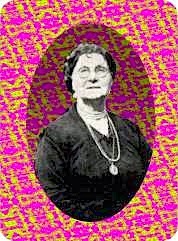Poor Amanda---blissfully unaware that her books weren’t collected for their literary merit, but for their production of unintended hilarity. At Oxford in the 1920s undergraduates like Evelyn Waugh and John Betjeman were admirers and it is said that the Inklings, whose members included C.S.Lewis and J.R.Tolkien , held competitions to see how much of a novel or poem by Amanda Ros could be recited before the reader began to laugh uncontrollably. Because most of her books were published privately in small editions, copies weren’t easy to come by. They have remained quite scarce ever since, largely due to loyal followers, who eagerly snap them up. However, today, with her star slightly on the wane, copies, including very early editions, can be found on the Net for under £70.
Ros’s work has been anthologised, but some enterprising publisher should reprint all her writings in a large paperback edition.[RH]
Thanks. From our old blog Bookride it is worth adding this:
One of her rarest books is Bayonets of Bastard Sheen ( 50 copies only in 1949). It was culled from letters written between 1927 and 1939 mostly vituperations against critics + a short piece 'Lewis Carroll. A Hasty Evaluation' prompted by the price of £15,400 paid by Dr. Rosenbach for the manuscript. She takes a very dim view of the Carroll book in several letters. Meanwhile here is a list of her synonyms for critics:
Apprentices to the scathing trade
Auctioneering agents of Satan
Brain-blighters
Brain-bruisers
Character-clipping-combination















+bis.jpg)























